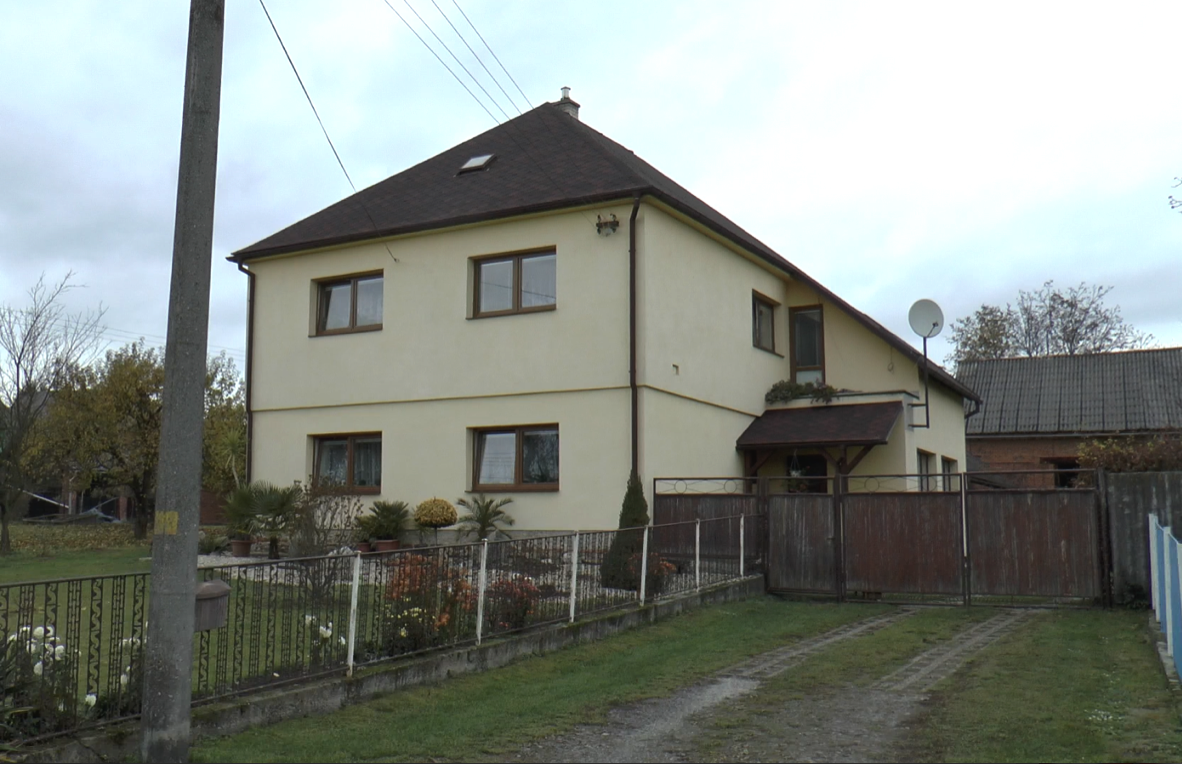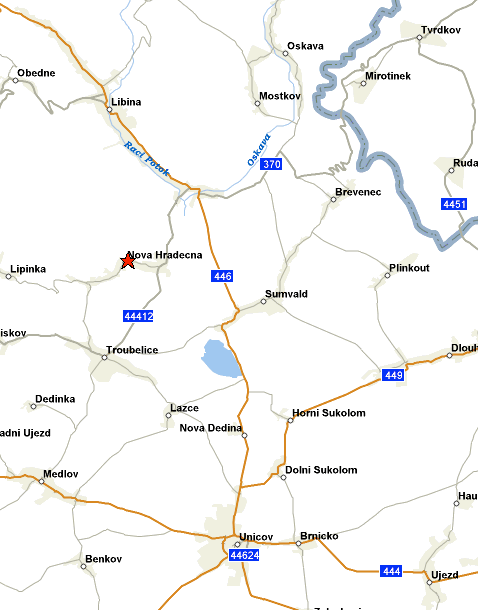Kresha Family Birthplace: House #33 then is now House #163

Raymond and Mary Kresha traveled to Nova Hradecna, CZ in the fall of 2015 and were shown where the original House #33 was. It was renumbered after the expulsion of German-speakers in 1948. In the 130+ years since the Kressas live here, the home has been remodeled, modernized and the lot subdivided. and is now House #163. The full story and explanation is in the book.
The village of Hradec (where this house is located) was consolidated in 1960 with the adjoining village of Hradecna, where the church is (St. Lawrence Catholic Church) and is now known as Nova Hradečná. In the 1890 census, Hradec had 65 houses with 426 Germans and 21 Czechs. Hradecna had 94 houses and 556 Germans and 19 Czechs there. Information is from Martin Pytr, www.czechkin.com.
For more information, you can go to Nova Hradecna's website at: www.novahradecna.cz. There is a Wikipedia article HERE.
The village of Hradec (where this house is located) was consolidated in 1960 with the adjoining village of Hradecna, where the church is (St. Lawrence Catholic Church) and is now known as Nova Hradečná. In the 1890 census, Hradec had 65 houses with 426 Germans and 21 Czechs. Hradecna had 94 houses and 556 Germans and 19 Czechs there. Information is from Martin Pytr, www.czechkin.com.
For more information, you can go to Nova Hradecna's website at: www.novahradecna.cz. There is a Wikipedia article HERE.
Records received by Marcie Etter and her mother, Lillian Kresha doing research mention House #33 in Hradec. The grandson of Joseph Kressa, Wilbur Frye, and his daughter Joell, made a trip to Nova Hradecna looking for this house in 2012. No one knew of the Kressas for two reasons:
1. Theodor and Cecilia moved to Jirikov sometime in the mid-1880's.
2. Hradec was a German-speaking village, was a part of Silesia/Sudentenland. They very sympathetic to Germany and after WWII, almost all German-speaking persons here and in Europe were expelled and were shipped to Germany, despite living in bilingual Moravia for many generations.
There are records in the municipal office that verify that Kressas lived here and lived in the home below, now numbered 163. More details in the book, "Kresha Family Roots in Moravia and Branches in America 2018."
1. Theodor and Cecilia moved to Jirikov sometime in the mid-1880's.
2. Hradec was a German-speaking village, was a part of Silesia/Sudentenland. They very sympathetic to Germany and after WWII, almost all German-speaking persons here and in Europe were expelled and were shipped to Germany, despite living in bilingual Moravia for many generations.
There are records in the municipal office that verify that Kressas lived here and lived in the home below, now numbered 163. More details in the book, "Kresha Family Roots in Moravia and Branches in America 2018."
Going Deeper:
For those of you who find the US census records, it says the Kresha's came from "Austria." Other records indicate that they were born in House #33, in Grätz, Austria. Grätz is the German name for the tiny village where they were born. In other times, it was known by the Czech name, Hradec.
They were baptized in the Roman Catholic Church, Saint Lawrence's, in Hradečná, the Czech name. It was also known as Markersdorff when the German language ruled things. These two villages were pretty much adjacent to each other. The Nova Hradecna website says that Nova Hradecna was founded in 1960 by the merger of two separate villages, Hradec and Hradecna, which extends on both sides of the road and the Brabinku Creek. Hradec and Hradečná are Czech names, Grätz and Markersdorf are the German names.
This is from the website:
"New Hradečná mountain village is located nine kilometers northwest of the city inc is a part of micro Unicov in the Olomouc region. It was founded in 1960 by the merger of two separate villages - Hradečná and Hradec, which extend on both sides of the road and creek Brabínku. The surroundings are attractive tourist, especially the Jeseníku Low hills and forested peak Bradlo, also called Moravian Blanik (601 m)." - (translation by Google)
The birth record for Cecilia Perikovsky is that she was born in Nova Dedina (Schrolffelsdorf in German) just a few kilometers south of Nova Hradecna, now part of Unicov, CZ
Most of those who came over in the 1800's said they were arriving from "Austria". Historically, the land mentioned above was called Moravia, but never was its own totally independent country. At the time of the Kresha immigrations, Moravia was a personal possession of the Holy Roman Emperor, annexed to Austria. Therefore, the Kressa's reported that they were from "Austria," but they were not from the Austria of today. They were known in some quarters as German Bohemians, originally ethic Germans invited into Bohemia a thousand years ago. They retained their language and their religion and were pretty much integrated, except for language and religion.
The house #33 in Hradec still exists, but is now numbered #163. It is in Nova Hradecna, Czechia. It is just 4-5 miles away from Nova Dedina/Unicov, birthplace of Cecilia Perikovsky. In the map below, you will find Nova Hradecna with a red star; just below it, Nova Dedina. Just below Nova Dedina, is Unicov, where some Kressa/Kresha records are found! Others are found in Olomouc, just south of Unicov.

If you are a family genealogist, you will notice many familiar names close to Nova Hradečná. The Nova Hradečná website today mentions that the St. Laurentius Church (St. Lawrence) serves not only Hradec and Hradecna, but also Troubelice, Lipinka and dates back to 1250. People who emigrated to the United States gave jobs to people from their home area because they knew the families, spoke the language, and were from the same parish. During the time of the Nebraska Homestead land rush, this area was referred to as Austria, short for Austria-Hungary Empire. Today it is part of the Czech Republic or Czechia.
There aren't any long-lost Kressa relatives left in the area as they spoke German and were early supporters of Hitler, before he started killing of Jews, the retarded, and homosexuals. German speakers from all over Europe were expelled in 1949 and transported to Germany, when hatred of all Germans was at a peak everywhere, even if they had never lived in Germany. More here.
There aren't any long-lost Kressa relatives left in the area as they spoke German and were early supporters of Hitler, before he started killing of Jews, the retarded, and homosexuals. German speakers from all over Europe were expelled in 1949 and transported to Germany, when hatred of all Germans was at a peak everywhere, even if they had never lived in Germany. More here.
